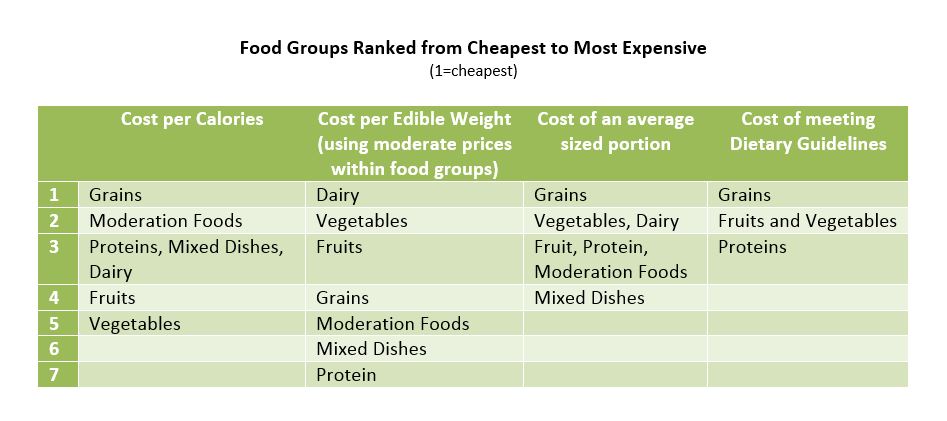
Is it really more expensive to eat healthier? Often, the general public assumes it is more expensive to eat healthier foods because an accurate method to analyze the costs of foods has not been available.
Realistically, it simply isn’t easy to say one food type is the least or most expensive because of the variety of choices in each food group. Think of food costs as a menu with three columns including the lowest, middle, and highest priced items in the restaurant. Imagine a consumer is in the mood for salmon and there are choices in each column. The salmon in the lowest price column is canned – in the middle price column it is farm raised – and in the highest price column it is wild caught Coho salmon plucked from Bristol Bay in Alaska and flown straight to a landing strip behind the restaurant. All three choices are salmon, but because of the way they are packaged, processed, caught, and shipped, the price differs. How much food costs depends on the choices consumers make about each food.
With so many choices, how do consumers understand the true cost and value of foods? Studies have found, after pondering these same questions that most people use the following methods to make food choices:
- Unit Cost-At a typical grocery store, consumers are used to seeing unit costs broken down, which is an excellent way to compare similar items, but makes comparison of different items (chicken versus crackers) difficult.
- Cost per Calories-Looking at the total amount of calories and dividing the cost could mean that a brownie is less expensive than a banana. The problem with this method is looking at the goal. Are most people trying to consume as many calories as cheaply as possible? With high obesity rates, this is not necessarily the goal, and not a very good approach.
The United States Department of Agriculture (USDA), looked at multiple ways of measuring the prices of foods to see if healthy foods are more expensive. They looked at measuring cost per calories, the price per edible weight, the price of an average sized portion, and the cost of meeting dietary recommendations. The findings were different for each method of calculation, which then leads back to the question: what is the overall goal? Do you want to eat healthier…shop for convenience foods…feel full during meal time…are you eating based on taste, etc.?
The food groupings that were tested as part of the USDA study included fruits, vegetables, proteins (meat, beans, nuts, poultry, etc.), grains, mixed dishes, and moderation foods. Moderation foods are those that do not “fit” into a food group, have excess saturated fat, excess added sugars, and excess sodium. Their findings were as follows:

As if trying to figure out what to eat isn’t difficult enough, this table illustrates that even if foods are evaluated on cost per calories, weight, portion size, and dietary guidelines, there isn’t an easy answer. Ultimately, grains seem to be the cheapest foods. If someone is concerned with being as healthy as possible, then eating to meet the Dietary Guidelines would likely be the most important column to use. However, the cost of the amounts of nutrients gained from different foods are not considered in any of the calculations.
Also, one food group that isn’t included in the Dietary Guidelines cost analysis are moderation foods, because there are no recommendations for eating them. In other words, they are not necessary as part of a healthy lifestyle.
Fruits and vegetables are filled with essential vitamins and minerals, and there is not a cost analysis that compares how many nutrients within the cost. Evidence does show that fruits and vegetables would be the best bang for the buck. In the end, fruits and vegetables should make up half of a plate, so by volume alone they will make up a good portion of anyone’s grocery bill. At multiple price points; canned, frozen, or fresh vegetables should be affordable and accessible. People tend to spend a large portion of their food budget on protein foods, though they are recommended in very small amounts. Following the Dietary Guidelines in this group would help to reduce this cost.
When it’s time to go grocery shopping, consumers can use this information understanding that foods have multiple price points (think back to the example of which salmon to choose as illustrated in the beginning of this article). Choosing foods that meet the Dietary Guidelines within your budget is the best way to shop. So happy shopping!
More detailed information is in the report by USDA: Are Healthy Food Really More Expensive?
Contributors
Elizabeth Shephard, University of Florida Institute of Food and Agricultural Sciences
Vanessa Spero-Swingle, University of Florida Institute of Food and Agricultural Sciences
Mel Morgan-Stowell, University of Florida Institute of Food and Agricultural Sciences
Sources
Carlson, A. and E. Frazao. 2012. Are Healthy Foods Really More Expensive? It Depends on How You Measure the Price. Economic Information Bulletin Number 96.Economic Research Service, U.S. Department of Agriculture.
Stewart. H., N. Blisard, and D. Jolliffe. 2003. “Do Income Constraints Inhibit Spending on Fruits and Vegetables among Low-Income Households?” Journal of Agricultural and Resource Economics 28(3):465-80.
